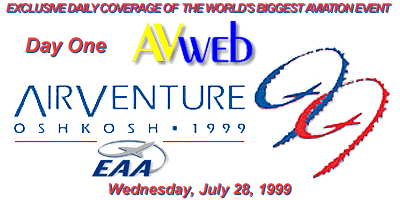TCM Comes Out Swinging
 NewLogo, New Engine Promotions
NewLogo, New Engine Promotions
It’s been a tough few months for the folks at Teledyne Continental Motors.For most of 1998, a hydraulic press used to assemble crankshafts for its mostpopular engine series — the 470, 520 and 550 big-bore sixes — was misadjusted.The press managed to damage the super-hard nitride coating on numerouscrankshafts, producing a stress riser. In turn, a few of the crankshafts failed,resulting in engine failure. Thankfully, there were no serious injuries —except perhaps to TCM’s bank account and to its reputation. Recognizing that thelatter is more important than the former, the company launched an aggressiveinspection and repair program, ultimately calling for inspection of the engineson some 3,500 aircraft around the world. AVweb‘s Mike Busch was righton top of it from the start and, although his airplane was not affected, heclosely monitored TCM’s reaction and the efforts the company made to find andfix the damaged cranks. Although the final episode in the saga of TCM’s 1998crankshafts has not yet been written, most in the industry give the company highmarks for the speed and completeness of its response. Many also believe that TCMhas set a new, higher standard for customer support in the general aviationindustry.
Fast forward to July. Despite the buffeting of the last few months, TCM seemsto have flown out of its turbulence and is setting a new course, with a new logoand changes in the way it markets its new, factory rebuilt and custom"Platinum" series powerplants. Among other moves, TCM is adopting anaggressive price schedule for its so-called "aftermarket new" engines,which are 100% brand-new and include all the latest updates. Featuring athree-year, 1,000-hour warranty, this powerplant option can be had for only a15% to 20% premium over a factory rebuild, according to the company. TCM’sPlatinum Series 300 hp IO-550 six-cylinder engine is blueprinted and each keycomponent is matched and balanced, resulting in a smoother, longer-lastingengine installation. Included in the Platinum deal is a five-year, unlimitedfactory warranty to TBO, five years of free engine oil analysis and two freeannual engine inspections. TCM’s Fairhope, Ala., facility must do theinstallation of the Platinum Series powerplant. But you’d better hurry. If youbuy a new TCM engine between August 1 and September 30 and obtain a coupon atTCM’s EAA AirVenture ’99 booth, TCM is offering a $500 rebate for each engine.Buy two.
Unison Jumps Into Spark Plug Market
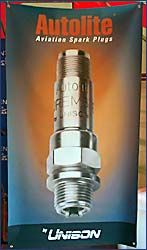 Unison Industries ignited the Oshkosh crowd Wednesday when it announced a new line of aviation spark plugs to add to its Slick magnetos and wiring harnesses. For 20 years, Unison’s goal has been to offer a complete ignition kit to engineoverhaulers and builders. The new Autolite Aviation Spark Plug line fulfills that mission and challenges Brand C’s monopoly on the market. The plugs are FAA-PMA approved and are available for Textron-Lycoming, Teledyne-Continental, Franklin, Pratt & Whitney, Curtis-Wright, and Jacobs engines.
Unison Industries ignited the Oshkosh crowd Wednesday when it announced a new line of aviation spark plugs to add to its Slick magnetos and wiring harnesses. For 20 years, Unison’s goal has been to offer a complete ignition kit to engineoverhaulers and builders. The new Autolite Aviation Spark Plug line fulfills that mission and challenges Brand C’s monopoly on the market. The plugs are FAA-PMA approved and are available for Textron-Lycoming, Teledyne-Continental, Franklin, Pratt & Whitney, Curtis-Wright, and Jacobs engines.
The new plugs have a bright nickelplate, which Unison expects to both last longer against the elements and blend in better with the chromed look on newer custom installations. The plug is designed for maximum lead-scavenging capability to reduce the chance of lead fouling. The new design also places the resistor under the glass seal inside the plug, which is expected to increase electrode life.
Unison is pricing a set of plugs about 5 percent less than Champion, and buying the plugs as part of a complete ignition kit offers more savings. Kit customers will get 8 plugs for the price of 6, and 12 for the price of 9. The other advantage to kit customers is one part number instead of three for a given engine type. The Northern Lights Aerobatic team is using Unison’s plugs in their Extra 300s while performing at AirVenture ’99.
 Autolite had abandoned the aviation market in 1986, along with many other GA players, during that decade’s economic downturn. Unison’s Autolite plugs will be manufactured in Rockford, Ill. Autolite, a division of Allied Signal, is the world’s largest manufacturer of spark plugs for cars and industrial applications.Massive electrode plugs should be available in mid-August for all Continental engines. Unison expects to announce a line of fine wire plugs early next year, perhaps timed to Sun ‘n Fun.
Autolite had abandoned the aviation market in 1986, along with many other GA players, during that decade’s economic downturn. Unison’s Autolite plugs will be manufactured in Rockford, Ill. Autolite, a division of Allied Signal, is the world’s largest manufacturer of spark plugs for cars and industrial applications.Massive electrode plugs should be available in mid-August for all Continental engines. Unison expects to announce a line of fine wire plugs early next year, perhaps timed to Sun ‘n Fun.
V/STOL For The Masses?
It’s Two, Two, Two Birds In One!
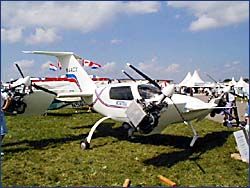 While the Moller Skycar and CarterCopter have been making news with theirattempts to produce a personal V/STOL aircraft, Duncan Aviation of Michigan hasbeen quietly toiling away on its own V/STOL design, and recently announced thefirst flight of its Xantus tilt-prop aircraft, named after a species ofhummingbird. The Xantus looks like a mini version of the Bell/Boeing V-22tilt-rotor, but with two more engines, and was unveiled to the public for thefirst time at AirVenture ’99. Duncan Aviation predicts the four-passengertilt-prop aircraft will take off and land vertically, cruise at 290 mph with arange of up to 800 nm, and have a fly-away cost of around $225,000.
While the Moller Skycar and CarterCopter have been making news with theirattempts to produce a personal V/STOL aircraft, Duncan Aviation of Michigan hasbeen quietly toiling away on its own V/STOL design, and recently announced thefirst flight of its Xantus tilt-prop aircraft, named after a species ofhummingbird. The Xantus looks like a mini version of the Bell/Boeing V-22tilt-rotor, but with two more engines, and was unveiled to the public for thefirst time at AirVenture ’99. Duncan Aviation predicts the four-passengertilt-prop aircraft will take off and land vertically, cruise at 290 mph with arange of up to 800 nm, and have a fly-away cost of around $225,000.
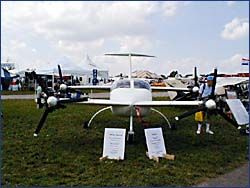 After receiving an airworthiness certificate from the FAA on July 7, theaircraft made its first tentative hovering flight on July 11. Xantus designerTerry Duncan is a lead engineer for Williams International and has sixinventions on the new Williams GAP engine. Duncan Aviation plans a cautious testprogram with a logical progression of flights to define the flight envelope ofthis unique aircraft. Duncan told AVweb that the first step in the flighttest program is to explore the hovering characteristics of the Xantus up to aheight of about 12 feet, to verify the V/STOL’s stability free of ground effect.After the hovering flight envelope has been explored, the engines will berotated to the horizontal position for a series of conventional takeoff andlanding tests from a 12,000-foot runway in Michigan. Only once Duncan feelscomfortable with the aircraft after these two phases will he tackle the trickytask of transitioning from hover to horizontal flight. If you’re visitingAirVenture ’99, the Xantus can be seen parked at booth 91 just north of the Dexhibition building. If you’re not at Oshkosh, you can check out the Xantus at DuncanAviation on the Web.
After receiving an airworthiness certificate from the FAA on July 7, theaircraft made its first tentative hovering flight on July 11. Xantus designerTerry Duncan is a lead engineer for Williams International and has sixinventions on the new Williams GAP engine. Duncan Aviation plans a cautious testprogram with a logical progression of flights to define the flight envelope ofthis unique aircraft. Duncan told AVweb that the first step in the flighttest program is to explore the hovering characteristics of the Xantus up to aheight of about 12 feet, to verify the V/STOL’s stability free of ground effect.After the hovering flight envelope has been explored, the engines will berotated to the horizontal position for a series of conventional takeoff andlanding tests from a 12,000-foot runway in Michigan. Only once Duncan feelscomfortable with the aircraft after these two phases will he tackle the trickytask of transitioning from hover to horizontal flight. If you’re visitingAirVenture ’99, the Xantus can be seen parked at booth 91 just north of the Dexhibition building. If you’re not at Oshkosh, you can check out the Xantus at DuncanAviation on the Web.
Cirrus Aircraft Takes A Second Step
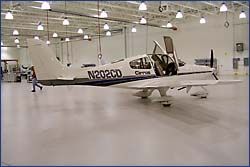 Afterdelivering the first production aircraft on July 20, Cirrus quickly followedthat milestone with a second production model delivered just three days later,according to Chris Maddy, director of marketing at the Duluth, Minn., aircraftmanufacturer. "There are now 324 airplanes on order and we expect todeliver 100 of them in the next 12 months," he told AVweb at thecompany’s display area here at AirVenture ’99.
Afterdelivering the first production aircraft on July 20, Cirrus quickly followedthat milestone with a second production model delivered just three days later,according to Chris Maddy, director of marketing at the Duluth, Minn., aircraftmanufacturer. "There are now 324 airplanes on order and we expect todeliver 100 of them in the next 12 months," he told AVweb at thecompany’s display area here at AirVenture ’99.
In order to get the airplane built, "We are currently ramping up forproduction," said Matt Kull, director of production. "Our nextobjective is to increase production to one plane per week." With fundingsecured and a flurry of hiring taking place, Cirrus is poised to add to its241-person workforce and increase production of the SR20.
On display was the second production airplane that had been delivered latelast week. The first Cirrus SR20 was also in Wisconsin, but tied down atAppleton airport, which will allow Cirrus to demonstrate the aircraft to morepotential customers.
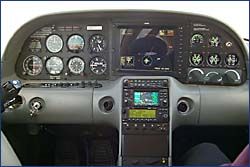 AVwebpublisher Carl Marbach flew the SR20 at the company headquarters and willpublish a complete pilot report in the coming month. "It was a pleasure tofly," he reported, "with the best-feeling ailerons and roll control ofany airplane I have flown. I felt comfortable in the airplane from engine startto shutdown. The four-seat interior is comfortable for all the occupants and thefuturistic panel completes the feeling that this is a new airplane."
AVwebpublisher Carl Marbach flew the SR20 at the company headquarters and willpublish a complete pilot report in the coming month. "It was a pleasure tofly," he reported, "with the best-feeling ailerons and roll control ofany airplane I have flown. I felt comfortable in the airplane from engine startto shutdown. The four-seat interior is comfortable for all the occupants and thefuturistic panel completes the feeling that this is a new airplane."
AviaBellanca Joins Forces With Spanish Company To Develop Skyrocket III
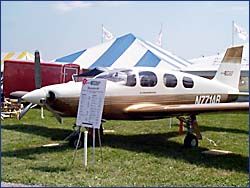 John Clark, CEO of AviaBellanca Aircraft Corporation, announced Wednesday atAirVenture ’99 that the company has reached an agreement to partner with GrupoEB-RIM, S.A., a Spanish firm that specializes in composite structures foraircraft. Grupo EB-RIM will provide financing and will manufacture parts for theAviaBellanca Skyrocket III, a six-passenger all-composite aircraft designed byAugust T. Bellanca. A proof-of-concept version of the aircraft is on display atOshkosh.
John Clark, CEO of AviaBellanca Aircraft Corporation, announced Wednesday atAirVenture ’99 that the company has reached an agreement to partner with GrupoEB-RIM, S.A., a Spanish firm that specializes in composite structures foraircraft. Grupo EB-RIM will provide financing and will manufacture parts for theAviaBellanca Skyrocket III, a six-passenger all-composite aircraft designed byAugust T. Bellanca. A proof-of-concept version of the aircraft is on display atOshkosh.
The company says the SkyRocket III will cruise 327 mph at 75 percent powerin the 435 hp configuration and have a range of 2,300 miles. It can be builtpressurized or non-pressurized. It will be offered initially in kit form, but thecompany plans to pursue Part 23 certification for factory production. Clark saidthat AviaBellanca has 20 orders for the airplane, which sells for $97,750without pressurization, less engine, interior and avionics.
AviaBellanca previously announced that the Orenda V-8 liquid-cooled engine wouldbe available as an option for the Skyrocket III. The Orenda develops 600 hp fortakeoff, and recently received its U.S. and Canadian type certificates.
Clark said that work will begin within the next few months on twopreproduction prototypes of the Skyrocket III, which will incorporate changes toreduce cooling drag, and a change in basic construction. The prototypes will usecarbon fiber over Nomex honeycomb to reduce weight, instead of fiberglass overaluminum honeycomb as used in the proof-of-concept plane. Clark expects buildtime on the prototypes to be about a year, and expects to begin delivering kitswithin 22 months.
The AviaBellanca Skyrocket is the latest in a long line of Bellanca-designedaircraft. August Bellanca’s father, Guiseppi M. Bellanca, began before World WarI to design aircraft known for their efficiency and speed. The Wright-Bellancawas Charles Lindbergh’s first choice to fly the Atlantic, but the deal fellthrough. Clyde Pangborn, in the Bellanca CH-300 "Miss Veedol," was thefirst to fly the Pacific. G.M. Bellanca designed the Cruisair and Cruisemasterseries of low-wing general aviation aircraft, but the Bellanca family andAviaBellanca have no connection with the current Bellanca, Inc., whichmanufactures the Viking.
S-Tec Introduces New GPS Roll-steering Autopilots
 Aftermarketand OEM autopilot manufacturer S-Tec Corporation announced a pair ofautopilots designed to bring a new level of flight-control capability to thesmall-plane owner, the System Forty X and the System Fifty X. Both new S-Tecmodels feature GPSS capability — or GPS Steering — to give direct left/rightsteering commands when linked to a GPS navigator equipped to output digitalcomposite steering commands. The steering input goes to the autopilot throughthe unit’s normal heading-input channel. The result is an autopilot capable offlying centerline-to-centerline course changes without hunting for the exactcourse or over-steering the aircraft. According to the company, as more avionicsmanufacturers add data for instrument approaches, these new flight-controlsystems will also be able to fly approach profiles output by the GPS. Neitherthe System Forty X nor System Fifty X follow a CDI’s needle deflections, butboth are capable of tracking a heading input from a DG, VOR/LOC and GPS, plusreversing course.
Aftermarketand OEM autopilot manufacturer S-Tec Corporation announced a pair ofautopilots designed to bring a new level of flight-control capability to thesmall-plane owner, the System Forty X and the System Fifty X. Both new S-Tecmodels feature GPSS capability — or GPS Steering — to give direct left/rightsteering commands when linked to a GPS navigator equipped to output digitalcomposite steering commands. The steering input goes to the autopilot throughthe unit’s normal heading-input channel. The result is an autopilot capable offlying centerline-to-centerline course changes without hunting for the exactcourse or over-steering the aircraft. According to the company, as more avionicsmanufacturers add data for instrument approaches, these new flight-controlsystems will also be able to fly approach profiles output by the GPS. Neitherthe System Forty X nor System Fifty X follow a CDI’s needle deflections, butboth are capable of tracking a heading input from a DG, VOR/LOC and GPS, plusreversing course.
S-Tec also has developed the new GPSS Converter for use with existing S-Tecautopilots, such as the popular System 30 and System 60, and for retrofit to anyother S-Tec flight controller. Similar to the GPSS feature of the two newautopilots, the $695 control box converts the heading channel to take GPSsteering input from GPS navigators that output steering information in thecomposite digital 429 code. S-Tec priced the single-axis System Forty X at$5,495, while the two-axis System Fifty X goes for $7,995, not including suchoptions as a DG, HSI or manual electric trim. The System Forty X and SystemFifty X should be available in the fourth quarter of this year, per STCs thecompany is in the process of developing. The GPSS Converter will be available inOctober.
Briefs…
Forums Area Gets Four New Pavilions, More Planned for 2000and 2001
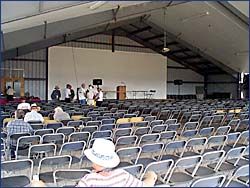 The forums area at OSH, where some of the most knowledgeable, interesting and informative peoplein aviation have spoken to sweaty crowds in hot, dark and musty tents, is in themidst of a major overhaul. New open-sided pavilions feature concrete floors,insulated ceilings, fans and built-in multimedia systems. The hope is that thepavilions will be cool and let participants see and hear presenters better.
The forums area at OSH, where some of the most knowledgeable, interesting and informative peoplein aviation have spoken to sweaty crowds in hot, dark and musty tents, is in themidst of a major overhaul. New open-sided pavilions feature concrete floors,insulated ceilings, fans and built-in multimedia systems. The hope is that thepavilions will be cool and let participants see and hear presenters better.
This year, three 400-seat buildings for general-interest presentationsand one 1,000-seat building forGAMA forums are finished and in use. America Online, Varilux, Sporty’s andJeppesen sponsored the first four buildings. Forums Coordinator Wes Schmid said three more buildings will be ready fornext year and the final four will be finished by 2001. Landscaping and treeswill be installed around the forum pavilions to create a more park-like setting,he said.
Half A Million And Counting, Young Eagles Take Off
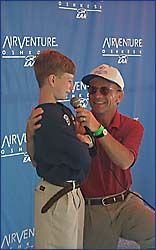 Steven Ward of Medina, Ohio, is only nine years old, and a little overwhelmedby all the attention. When Tom Poberezny introduced him to a crowd Wednesdaymorning as Young Eagle No. 500,000, he beamed a wide smile but was at a loss forwords. But it was clear, as Poberezny placed a fatherly hand on Steven’sshoulder and prompted him a bit, the memory of his first flight in a small planewas still bright and shining. Ten years from now a little guy like Steven couldbe a full-fledged pilot, and as Poberezny made clear, that’s what the YoungEagles are all about. By reaching out to children, the EAA and its members hopeto build an infrastructure to carry general aviation into the future. The YoungEagles program also offers camps and school lessons to fuel that spark ofinterest beyond the first flight. The goal of flying a million young people by2003, which once seemed pie in the sky, now seems right over the horizon.
Steven Ward of Medina, Ohio, is only nine years old, and a little overwhelmedby all the attention. When Tom Poberezny introduced him to a crowd Wednesdaymorning as Young Eagle No. 500,000, he beamed a wide smile but was at a loss forwords. But it was clear, as Poberezny placed a fatherly hand on Steven’sshoulder and prompted him a bit, the memory of his first flight in a small planewas still bright and shining. Ten years from now a little guy like Steven couldbe a full-fledged pilot, and as Poberezny made clear, that’s what the YoungEagles are all about. By reaching out to children, the EAA and its members hopeto build an infrastructure to carry general aviation into the future. The YoungEagles program also offers camps and school lessons to fuel that spark ofinterest beyond the first flight. The goal of flying a million young people by2003, which once seemed pie in the sky, now seems right over the horizon.
Tuskegee Airmen Take It Easy On The Ground
They didn’t bring any airplanes, but on Wednesday morning three World War IIveterans generated a quiet but powerful presence in the "D" ExhibitHall. Seated behind a table filled with books for sale about the illustrioushistory of their group, Milton Williams explained that the Tuskegee Airmen, withchapters around the country, are dedicated to serving young people. The chaptersraise money for scholarships for promising students, and the competition is opento children of any race. "We don’t want to turn around and do to otherswhat was done to us," Williams said. Airman Robert Martin suggested thatpage 63 in one of the books was worth a look: Yes, that’s him and his brother,fifty-some years ago, and they’re both pretty handsome, don’t you think?
An Airplane On Mars?
The scientists at NASA like to call their contraption an airplane, but itlacks most of a pilot’s favorite features — such as a fuselage and a cockpit,for starters. More like a flying wing, the solar-powered flyer neverthelesscould prove to be the first extraterrestrial aircraft. And Mars could be justthe beginning — several other planets and moons in the solar system haveatmospheres that could support flying machines, and you can be sure our folks atNASA are taking a close look at each one.
World’s Biggest 182 Lands Short Of OSH
A pilot and his passenger, on their way to AirVenture ’99 from Tylertown,Miss., escaped with minor injuries after landing their Cessna 182 in a soybeanfield near Fond du Lac, Wis., after some trouble with the engine. One mediareport that AVweb saw described the 182 as a "small commuterplane," so we figure this must have been the rare stretched version, on itsway to a display on the Experimental flight line. Or is it possible the mediagot it wrong, again?
Lighter-Than-Air Is Just Not There
AirVenture may be the world’s largest aviation event, but it’s still not bigenough to encompass every type of sport flying. The only representative of theLTA contingent that AVweb could find was a tiny helium globe flying 100feet above the beer tent.


































